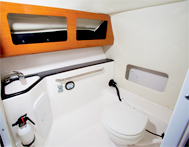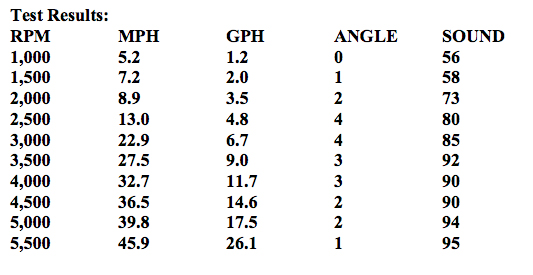|
 |
The following review was written by John Page Williams, Editor-at-large, Chesapeake Bay Magazine. John, senior naturalist for the Chesapeake Bay Foundation, has been a regular contributor to Chesapeake Bay Magazine for 30 years, specializing in environmental issues, nature, wildlife, fishing and boats. He has been testing new and used boats for the magazine's Time-Tested and New Boat News departments since 1998.
|
 |
| AUGUST 2015 |
| |
| |
 |
|
Length overall 24' 6"
|
Beam 8' 6"
|
| Draft 1' 9" |
| Weight 3,550 lb |
Fuel 120 gal
|
Water 19 gal
|
| Base Price $119,243 |
|
Yes, technically speaking, the open bow with cushioned seats in the 245CX from EdgeWater Powerboats qualifies her as a bowrider, but the CX stands for Crossover. Truth to tell, the 245CX has enough interior space to make her a fine family boat, but her hull design and construction make her as seaworthy and fishable as a center-console. The hose-it-out self-bailing cockpit and limited-lifetime hull warranty mark her as a truly multi-functional vessel—you can even dress her up for an elegant buffet dinner.
Designed to Perform
A look at her bottom shows a sophisticated hull shape designed by people who mix academic training with hands-on engineering and on-the-water experience. EdgeWater Powerboats makes it a point to spend time with the company’s customers, long-time boat owners who know what they want and need, such as a truly functional head, radiused handrails wherever they naturally reach for support in a seaway, well placed spring line cleats, and clear sightlines from the helm. The most visible—though not the only—interaction is the carefully organized owners’ expedition that EdgeWater’s long-time president, Peter Truslow, runs each year from Fort Pierce, Florida to the Bahamas. That trip is a great proving ground for the boats, and a great opportunity for Truslow and other participating staff to take notes.

Design for the 245CX comes from a close collaboration between EdgeWater’s in-house design team and the wide range of new-product capabilities of Marine Concepts, a top-shelf design/engineering/tooling shop across the Florida peninsula in Cape Coral. The 245CX shares its hull shape with its 245CC (center-console) sister. Underway at speed, the hull rides on a delta-shaped surface with a constant and relatively deep 20-degree deadrise that extends approximately to the consoles before making a quick transition into a sharp bow entry. A pair of strakes on each side provide lift as the boat rises onto plane.
On our sea trial, this combination produced a soft ride in 2- to 3-foot seas. Outboard of the “delta” running surface, the hull’s deadrise flattens out, with wide, reversed chines at the outer edges. Between the lifting strakes and the chines, the hull kept the 245CX’s windshield completely dry in those messy seas. When quartering into them, we used the boat’s Lenco trim tabs to raise the windward side, which softened the ride and suppressed the spray even more.
Adapting the 245 hull to a dual-console configuration meant working out the placement of interior weight centers like the 120-gallon fuel tank, the 19-gallon water tank, the portable toilet and the twin Group 29 batteries to balance the hull properly both at rest and at speed. It also meant adjusting balance according to the locations where people are likely to stand, sit and congregate in a dual-console interior instead of around a center console.
To serve both the CX and CC configurations—which the 245 hull does very well—the topsides carry the full 8-foot-6-inch beam well forward, opening up space in the bow. In the CX version, the result is a large compartment in front of the tempered glass windshield. Under proper sea conditions, this area can function as a safe wind-in-the-hair riding space for children in sight of their parents, or a comfortable four-adult buffet spot (a folding table is standard), or a stripped-for-action casting deck. An anchor roller and windlass are standard.
Combined with the spaces under the bow seats, the two consoles serve specific functions. To starboard is a large helm that offers those good sightlines; a dash that accommodates a flush-mounted 12-inch LCD display (EdgeWater offers several Garmin packages factory-installed), a linked-in VHF radio and a flush-mounted stereo; and, underneath, cavernous dry storage, accessible through a stout hatch in the walk-through. To port is a head/changing room designed for adults as well as children (4-foot-5-inch headroom), with a door whose upper edge curves into the console’s top, so no bumped heads entering or exiting. The standard head is electric, with freshwater flushing and a holding tank.
Helm and companion chairs offer flip-up bolsters to convert to leaning posts. A back-to-back folding port seat is optional ($154), as is a wet bar and sink to starboard behind the helm seat ($2,212). Between the seats is a long in-sole compartment for skis and water toys. A fiberglass hardtop is standard, including spreader lights and a ski tow bit, with an optional Bimini top for the cockpit ($2,483). The cockpit is spacious, ending in a large central seat with a lift-out fishbox. Beneath is access to plumbing, wiring and mechanical systems. The transom holds an upholstered back cushion for the seat, plus a door to the aft deck to starboard and a 28-gallon livewell to port. Other useful options include SeaStar power steering ($2,158) and pull-up (instead of fixed) cleats ($810).
Built to Last
The EdgeWater website offers several videos describing the company’s production process, from computer-assisted design and engineering through materials and hull layup to assembly. Like all EdgeWaters from 22 feet up, the 245CX is built with the company’s proprietary Single Piece Infusion vacuum-bagging system, which its engineers successfully adapted to the hull’s design. Those engineers specify a combination of knitted bi-, tri- and quadraxial fabrics, foam cores with varying densities and flex characteristics, and a heavily reinforced Penske Board transom. The lamination crew sets each boat’s kit of materials into the mold dry before installing the vacuum bag and precisely applying vinylester resin to bring the whole hull/stringer package together with a strong primary bond. With foam filling all voids left in the hull, it becomes unsinkable, exceeding Coast Guard floatation requirements.
The engine of choice for the 245CX is Yamaha's elegant 4.2-liter F300. At 580 pounds, it is a lightweight among big-block V-6 outboards. Top speed is in the upper 40s. At efficient cruising speeds in the upper 20s and low 30s, our test boat loped through the seas easily in all directions, even quartering into them.
The dryness of this Crossover’s windshield throughout our test is evidence of an often-overlooked virtue in top-quality boats: the value of good tooling. Marine Concepts builds the plugs and molds for EdgeWater with a precise five-axis router that executes the designers’ shapes faithfully. The plugs transfer those shapes to the molds, which shop crews maintain carefully, so that finished hulls follow their designs exactly. Look at the running shot that accompanies this test. Notice how the lifting strakes and chines force spray straight out instead of allowing it to curve upward into the boat. That precision also makes those features more effective in lifting the hull. It's one more reason why EdgeWater's 245 CX is a great investment in family boating.

Contact information:
Chesapeake Dealer:
Annapolis Yacht Sales 410-267-8181; www.annapolisyachtsales.com
AYS additional locations in:
Deltaville, Va. 804-776-7575
Rock Hall, Md. 410-639-4082
Stevensville, Md. (Kent Island) 410-941-4847
EdgeWater Boats, Edgewater, Fla. 386-426-5457; www.ewboats.com
|